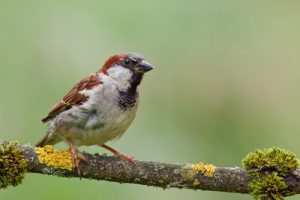House Sparrow Numbers Are Declining. You’re Kidding!
By Chris Williams on March 9, 2012.
House sparrows were intentionally introduced into North America in the 1850’s. It was thought that they would eat cankerworms and other pests attacking city trees. It was soon discovered that the birds could care less about cankerworms. What they really liked to eat was the undigested grain found in horse droppings. And there was no shortage of horse droppings in 1850’s America. House sparrow populations boomed in a country that was dotted with small farms that supplied a diet of cereal grains and fly larvae associated with livestock. House sparrow numbers fell dramatically for a time in the 1920’s as the automobile replaced the horse.
 Since the 1950’s, pesticides have reduced insect numbers, livestock is more spread out, and grain harvest and storage is more efficient. All of this has meant a continuing decline in the house sparrow population of 2.6% every year. While overall numbers may be lower, sparrows have made the move from rural areas to concentrate their numbers in urban areas. They seem more abundant since they have become a closer part of our lives.
Since the 1950’s, pesticides have reduced insect numbers, livestock is more spread out, and grain harvest and storage is more efficient. All of this has meant a continuing decline in the house sparrow population of 2.6% every year. While overall numbers may be lower, sparrows have made the move from rural areas to concentrate their numbers in urban areas. They seem more abundant since they have become a closer part of our lives.
House sparrows are aggressive opportunists. They have adapted to the changes in America’s landscape. Since they can no longer depend on food from dwindling American farms, sparrows have learned to live with us in urban and suburban areas instead, where they still depend on us for food. Instead of grains, they’ve introduced McDonald’s French fries into their diets. Instead of nesting in barn lofts, house sparrows nest in attic vents, in gutters, behind building signs, in light fixtures…and even inside retail stores.
House sparrows have become standard residents of warehouses and big box stores. Walk into your local home improvement store with its high ceiling and beams just right for perching and you will almost certainly see a bird or two up there twittering away. For house sparrows, big box stores are the horse barns of the 21st century. The stores are warm, there’s the birdseed aisle, and there are no predators like cats or hawks. Sparrows have even learned how to trip the automatic doors so they can come and go as they please.
Lest, you think that house sparrows have abandoned the farm completely, they are still the most common bird in and around farm buildings. They are also the most common bird in cities in the U.S. House sparrows are in no immediate danger of dying out.